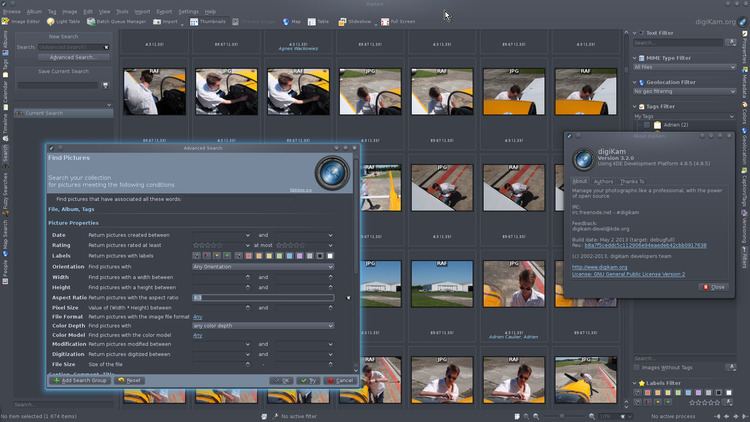Operating system | Written in C++ (Qt) | |
 | ||
Stable release 5.4.0 / January 10, 2017; 55 days ago (2017-01-10) Repository projects.kde.org/projects/extragear/graphics/digikam/digikam-software-compilation/repository Type Image viewerImage organizerPost-production tool | ||
digiKam is a free and open-source image organizer and tag editor written in C++ utilizing the KDE Platform.
Contents
Features
digiKam runs on most known desktop environments and window managers, as long as the required libraries are installed. It supports all major image file formats, such as JPEG and PNG as well as over 200 RAW file formats and can organize collections of photographs in directory-based albums, or dynamic albums by date, timeline, or by tags. Users can also add captions and ratings to their images, search through them and save searches for later use. Using plug-ins, users can export albums to various online services including (among others) 23hq, Facebook, Flickr, Gallery2, Google Earth's KML files, Yandex.Fotki, MediaWiki, Rajce, SmugMug, Piwigo, Simpleviewer, Picasa Web Albums. Plug-ins are also available to enable burning photos to a CD and the creation of web galleries.
digiKam provides functions for organizing, previewing, downloading and/or deleting images from digital cameras. Basic auto-transformations can also be deployed on the fly during picture downloading. In addition, digiKam offers image enhancement tools through its KIPI (KDE Image Plugins Interface) framework and its own plugins, like red-eye removal, color management, image filters, or special effects. digiKam is the only free photo management application on Linux that can handle 16 bit/channel images. Digital Asset Management is the mainstay of digiKam.
Version history
The 0.10 version is a hallmark in development as it integrates digiKam in the KDE Platform 4 environment, which is now available on all major platforms as Unix-like, Mac OS X, and Windows (XP, Vista and 7). New features are: XMP metadata, DNG format read and write, database file is independent of photo libraries, enabling remote paths, multiple roots and offline archives, improved database with much more metadata that can be searched, e.g. camera or lens, Marble integration for geolocation, non-modal image editor, live search boxes in both sidebars and main window, and many more.
New features in the 0.9 series include a GPS locator and synchronization, iPod Photo upload support, an advanced metadata editor, better support for the Raw image format (using dcraw included in digiKam), full color management, a light-table, pan-tool in Image Editor and Preview mode, improvements in usability, and many new plugins.
digiKam 2.0 was released in July 2011, sporting a number of new features, including:
Awards received
digiKam has been awarded the TUX 2005, 2008, and 2010 Readers' Choice Award in the category Favorite Digital Photo Management Tool.
